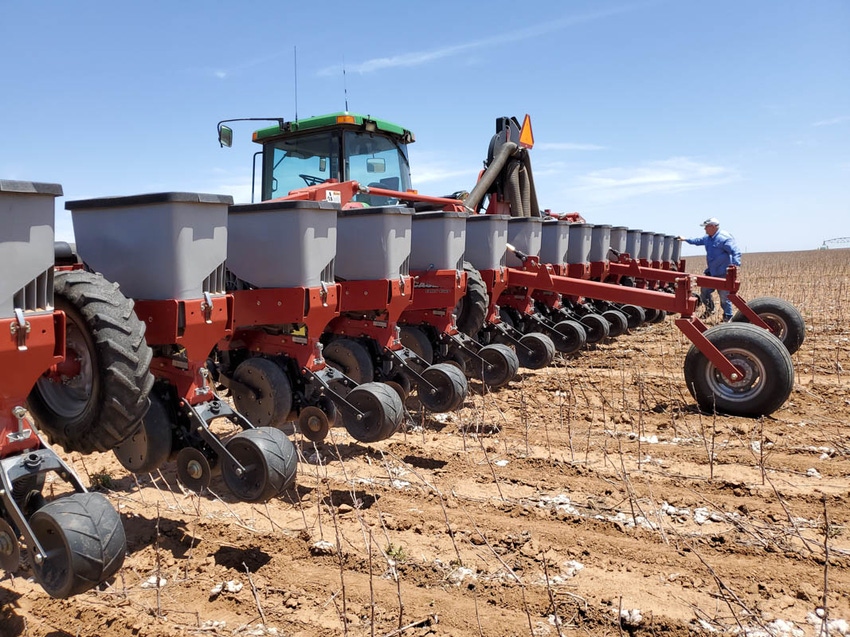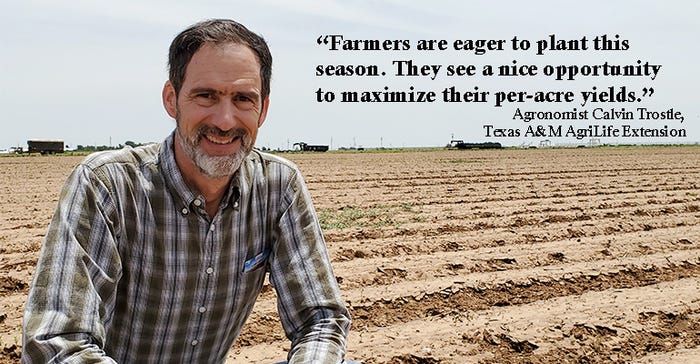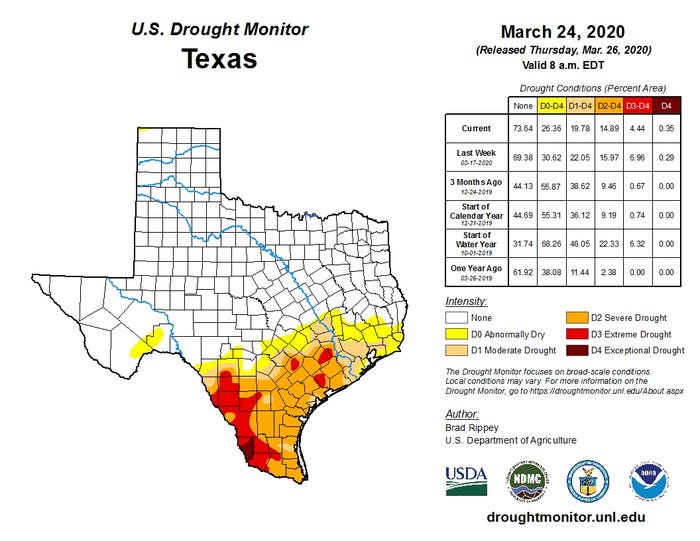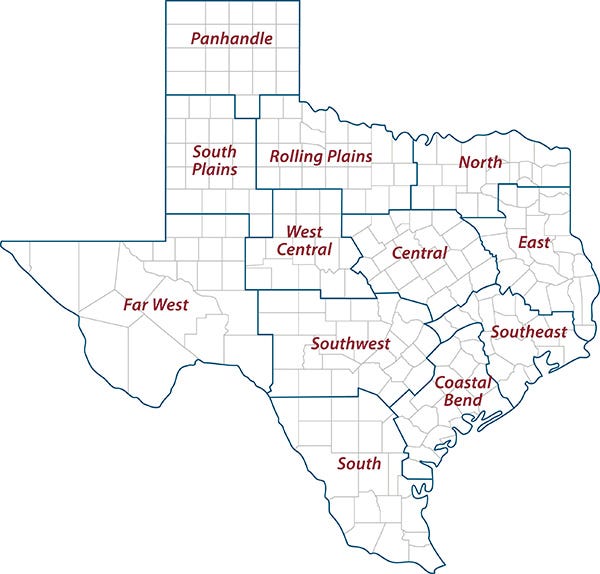
Rains last fall filled soil moisture profiles for much of the state and set up a good yield potential for Texas farmers, according to a Texas A&M AgriLife Extension Service expert.
Calvin Trostle, AgriLife Extension agronomist, Lubbock, said lines between areas with plenty of good soil moisture and those dealing with drought were distinct. Big rains in the fall delivered deep soil moisture throughout the “root zone” for most areas, while much of South Texas and along the Gulf Coast continue to struggle with drought.

The difference in good soil moisture – 4-5 feet down – can make a big impact on harvest yields, he said.
“The place you want to be is your soil holding as much moisture as it can hold going into the cropping season,” Trostle said. “Deep soil moisture and regular rains through summer could bump yields of corn, sorghum and cotton up 10%-20%, and even more if you’re a West Texas dryland farmer. That moisture makes a huge difference.”
Soil moisture makes the crop
The High Plains and Rolling Plains from Midland to Big Springs up to the top of the Panhandle and along Interstate 20 from Abilene to Wichita Falls received good fall and winter moisture. Those rains brought much of those areas out of drought and created a deep soil moisture profile.
“The difference between soil holding 5 inches of rain compared to 2 inches of rain at 5 feet deep is big,” he said. “That 3 inches of moisture translates into 1,000 pounds per acre for a sorghum producer. It’s around 150-200 pounds of lint per acre for cotton producers. That’s huge.”
Trostle said dryland farmers in the High Plains who receive average summer rain could see up to 480-pound lint yields, or 1 bale per acre with the combination of moisture and improved cotton varieties. A typical year yields around 250 to 300 pounds of lint per acre.
“Farmers are eager to plant this season,” he said. “They see a nice opportunity to maximize their per-acre yields.”
Little to no rain
In the southern half of the state, rains have been scattered at best.
Josh McGinty, AgriLife Extension agronomist, Corpus Christi, said most of the region was in D2 stage drought, or severe drought, according to the U.S. drought monitor.

“A week ago, much-needed rains fell across some of the more inland counties but missed those of us along the coast,” he said. “Corn and grain sorghum fields have emerged to good stands in most areas but there are some inconsistent skimpy stands where soil moisture was marginal.”
McGinty said timely rains would have helped even those fields but have not developed so far. Most producers were finishing cotton planting and were hoping chances of rain in the forecast will materialize.
AgriLife Extension agent reports from other southern parts of the state reported spotty crop emergence, failed germination and delayed plantings due to severe to extreme drought.
AgriLife Extension district reporters compiled the following summaries:

CENTRAL
Producers need to get into fields, but moisture was preventing work in much of the district. Nearly all counties reported adequate soil moisture and good rangeland and pasture conditions. Pecan and mesquite trees were budding. Cattle markets were still down. Livestock were in good condition. Pastures were greening with full tanks and good soil moisture. Supplemental feeding of livestock decreased significantly. Some fields of small grains began to head out. Corn was emerging well. Fruit trees were blooming, and producers were applying herbicides on weeds in hay pastures.
ROLLING PLAINS
Conditions were warm and sunny. Winter wheat conditions continued to improve. Ranchers continued supplementing cow-calf and stocker operations with protein and hay where forages were limited. Producers were preparing fields for spring planting.
COASTAL BEND
Dry soil moisture conditions continued to delay planting. However, some producers moved forward where the soil moisture allowed. All cotton planting would be complete in southern areas had there been enough moisture. Northern areas were beginning to plant cotton as able. Most corn and grain sorghum fields were planted. Fields continued to grow and looked good but will need rain soon to stay on track. Rice planting was underway. Some producers were working on weed control. Pecan nut casebearer scouting program will be initiated soon. Producers fertilized rangeland and pastures and hoped for follow-up rains. Pastures were green but not growing at the normal pace, thus feeding of hay and protein to cattle continued. Cattle prices fell amid high inventories. Most livestock were still in good shape.
EAST
Pastures were beginning to green up but drying out with warmer temperatures. Pasture and rangeland conditions were good. Subsoil and topsoil conditions were adequate. Trinity County reported recent rains caused flooding along the Trinity River. Livestock were in good condition with many producers no longer feeding hay. Cattle market prices were down. Houston County reported gnats and flies were a constant nuisance to livestock. Wild pigs remained active and caused damage.
SOUTH PLAINS
Subsoil and topsoil moisture levels were good. Winter wheat and rangeland were in fair condition. Some farmers were planting oats and others were spraying wheat to get ready for cotton planting. Pastures were in good condition with the recent rains. Cattle were reported to be in good condition.
PANHANDLE
Subsoil and topsoil moisture levels were adequate. Pastures and rangelands were fair and slowly beginning to green up with warmer temperatures. Winter wheat conditions were fair to excellent. Some wheat streak mosaic and rust were reported in various fields. Stocker cattle were being moved from wheat-for-grain fields to graze out wheat. The central Panhandle reported adequate topsoil moisture and adequate subsoil moisture. Pastures and rangelands were poor to fair.
NORTH
Topsoil moisture levels were mostly adequate to surplus. Daytime temperatures in the 90s with winds ranging from 15-25 mph dried up standing water after recent rains. Ponds were full. Bermuda grass was actively growing. Winter wheat was doing well and experienced some growth during the sunshine and warm weather. Winter/spring pastures were doing well with the sunshine. Livestock were in good condition and taking advantage of the spring forage growth. Reports of feral hog damage increased significantly.
FAR WEST
Temperatures averaged in the upper 90s with lows in the mid-40s. High winds put the district under a red-flag warning. Rain averaged between trace amounts and 2 inches. Cotton producers started applying herbicides and prepared to plant in about 45 days. Rangeland conditions were improving. Winter wheat made good stands and should produce well. Alfalfa weevil hit fields hard this year. Some farmers sprayed, while the others mowed. Chile planting started. Pecan farmers were finishing last-minute pruning and preparing for irrigation. Livestock conditions were fair to good amid fair pasture conditions. Lambing and kidding were almost complete. Producers continued to feed livestock and wildlife.
WEST CENTRAL
Conditions were warm and sunny. Pastures and forages were growing, and some warm-season forages were emerging. Mesquite trees were breaking winter dormancy. Sorghum planting started and should pick up pace soon. Most ponds and tanks were full. Livestock were in fair condition. Supplemental feeding of livestock slowed.
SOUTHEAST
Overall, pasture conditions were good, and forage were growing well. Livestock body scores averaged 4 going into the spring/summer. Rice plantings progressed. Areas that missed rains required rice farmers to stop and flush fields to germinate seeds to get an even stand. Walker County reported rainfall saturated some areas. Rangeland and pasture ratings varied widely, from excellent to very poor with good ratings being most common. Soil moisture levels ranged from adequate to very short with adequate levels being most common.
SOUTHWEST
Rain fell across most of the district with reports ranging from light rain up to 6 inches. Temperatures warmed up and improved crops and pastures. Oats, wheat, barley and corn were starting to progress. Peach orchards were looking good. Cabbage and onion were still in fields. Grain sorghum planting was wrapping up with cotton planting to start soon. Livestock conditions were good.
SOUTH
Weather conditions were mild with very short to adequate soil moisture levels. Some areas of the district received trace amounts of rain. La Salle County reported 1-2.5 inches of rain. Rain amounts for the year there were at 3 inches so far. Areas of Hidalgo County, which was in severe to extreme drought, received half an inch to 3.5 inches of rain. Live Oak County reported about 8% of the county received abundant rainfall with 42% receiving beneficial amounts and 50% of the counties reporting trace amounts. Potato fields were flowering. Corn planting was mostly complete. Wheat and oats were heading. Pasture and rangeland conditions were poor in most areas but were starting to improve with recent rains. Supplemental feeding for livestock continued. All irrigated Coastal Bermuda fields were green and almost ready to start making hay bales. All vegetable crops were planted and irrigated by canal systems. Cabbage and spinach harvests continued. Corn and cotton were irrigated. Irrigated corn and sorghum fields in Hidalgo County were stressed due to 95-degree days. Oats and wheat continued to mature early due to dry conditions. Irrigated wheat made good progress and was heading nicely. Onions also made good progress. Dimmit County reported they were still dangerously dry and needed a follow-up rain. Zapata County reported extreme drought levels and some bare pastures. Producers there continued to sell off cattle or feed hay and cubes. Little to no planting was occurring in Starr, Jim Wells, Kleberg and Kennedy counties due to drought, and pastures looked extremely stressed. Jim Wells County reported some wheat fields had failed.
Source: is AgriLife TODAY, which is solely responsible for the information provided and is wholly owned by the source. Informa Business Media and all its subsidiaries are not responsible for any of the content contained in this information asset.
About the Author(s)
You May Also Like




